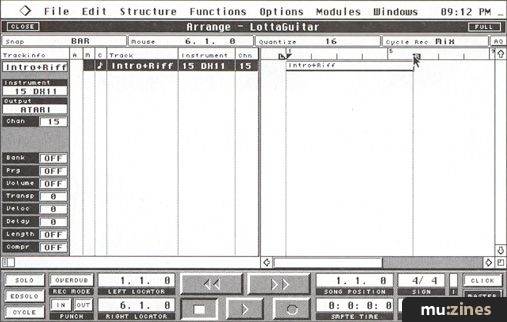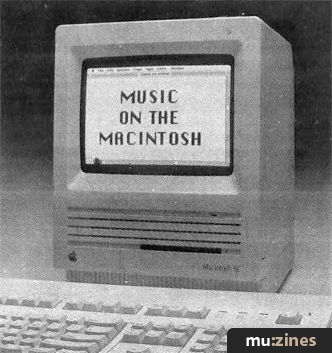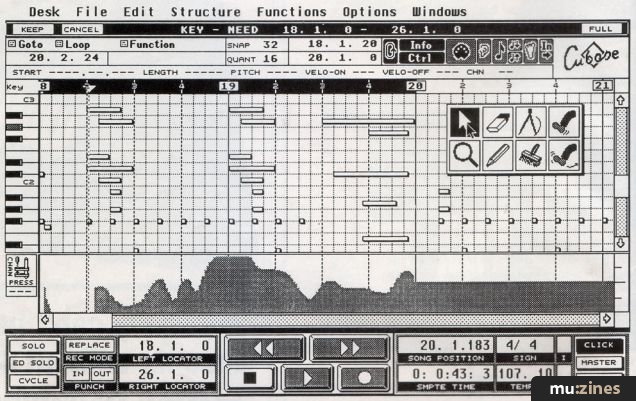Magazine Archive
Home -> Magazines -> Issues -> Articles in this issue -> View
Article Group: | |
Dream sequences (Part 5) | |
Article from The Mix, April 1995 | |
Roger Brown continues his exploration of the Interactive Phrase Synth...
After producing a drum and bassline from an original drum pattern last month, Roger 'James' Brown continues to dissect the analogue sequencing mimicry of Cubase's Interactive Phrase Synthesiser. This month, he puts poor old Pachelbel's Canon to 'the acid test'.
In last month's introduction to the Interactive Phrase Synthesiser, we kept things uncomplicated and simply used the IPS to revoice our drum pattern by pitch-shifting and Mute Play, and generated a one-note bassline by using the Repeat function to carry the rhythm of our drum pattern over to the bass. Repeat generates a repeating note, which is the original input note laid over the rhythm of our original phrase. All very well for minimalist basslines, but what do we do if we want to produce a melodic bassline from our source material?
To produce other melodic material from an original pattern, it is necessary to turn to the central set of filters on the IPS page, and do some manipulation from there. We have already looked at simple transposition using the Pitch Filter, but the other two filters can be even more useful in transforming source material. This month, instead of spinning out our drum pattern even more, we'll take a look at producing a new, melodic pattern by taking a slow chord sequence and chopping up the rhythm into something more riff-like.

Record patterns by setting the output to MROS
If you look at figure 1 you'll see that the IPS is set up, as in last month's example, to simply retrigger a chord pattern according to the key we input from the keyboard. Let's just record that as it is, by setting the Output to MROS and record into a track on the Arrange page. Now we'll move to IPS A, and take the same chord sequence and see if we can't make something a little more funky out of it.
The chord sequence is a familiar one, my pastiche of Pachelbel's Canon in C Major. We used the Logical Editor on this to produce a MIDI volume gate in part 3 of this series, and the result was a little more rhythmic than the original two bar chords. Let's see if we can't get something even more riff-like, with the assistance of the IPS.

Transpose the original up an octave from the pitch filter...
As a first step, I've set the Pitch Filter to transpose our phrase up an octave, so we can hear our phase over the original, as shown in figure 2. The next step is to introduce some rhythmic variation into the phrasing. We can do this initially, by using one of the Rhythm filter's LFO's to 'play' the phrase, and introduce some variation as the IPS replays the phrase, according to the 'pulse' of its virtual LFO. This introduces a slight variation to the original phrase, but not enough to qualify as a bass or lead line. To do that, we need to break up our pattern into shorter notes.
If you look to the right of the Rhythm filter, you will see we have a few ways of doing this. The frequency filter will increase or decrease the occurrence of the phrase, on a percentage basis from 1-200%. As a setting of 200% here will effectively double the incidence of the notes, producing a jumping bassline, we'll ignore that and the Amplitude filter, which really only determines the attack level.

Then set an LFO to vary the Rhythmic structure...
Let's turn instead to the two settings which directly affect the length of the notes, and their quantisation. Setting the length of the notes to 16T (sixteenth triplets), as in figure 4, turns out short notes, but the original phrase is still based around two-bar quantisation, which is not quite the effect we're after. The Q filter is the one to set to produce a faster or slower rhythm. If we set this to eight, for instance, the musical phrase will be quantised to eight measures, producing a slow, walking bassline effect. Moving the quantisation up to sixteenths (see figure 5) results in a faster, more rhythmic phrasing, and provides us with an ideal pattern for sending out to those acid patches.

and set the note length to sixteenths triplets...

and quantisation to sixteenths to produce some serious riffing!
We can vary the order of the notes, to give a more random factor to the acidic leadline we've now produced with the LFO in the Pitch filter. In the pitch filter, the LFO simply takes the notes fed to it by the Interpreter list, while the LFO rate (between 0.1 and 30 repetitions per second) controls the speed and order of replay. This is an effect which is open to experimentation, and you can even alter the LFOs in real time whilst recording, which is ideal for turning out evolving leadlines.
If you are too much of a slacker to do that, you can set the IPS to do that for you as well. Go to one of the two Modulation filters at the bottom of the page, and set the filter to control either Pitch:LFO, as shown in figure 5, or Pitch:LFO Frequency. Choosing an LFO for the Modulation Filter will then activate this, and you can watch as the LFOs or the LFO Frequency in the Pitch filter change and affect the notes being played.

Setting one of the modulators to control the pitch LFO means the IPS is 'playing' itself!
That's all for this month folks! Have fun experimenting with the various filters within the IPS, and see if you can come up with some stormin' acid basslines. I have actually chosen to play this pattern on an electric guitar patch, for a bit of rockist riffing as the original chord pattern is still intact. It's just reduced to a bunch of sixteenth notes, but this is ideal for either acid 303 or guitar riffing, lending credence to the view that the 303 is the electric guitar of the '90's.
On the RE:MIX CD

Roger 'James' Brown gets down, trying to put some gunpowder into Pachelbel's Canon.
Series - "Dream Sequences"
Read the next part in this series:
Dream sequences (Part 6)
(MX May 95)
All parts in this series:
Part 1 | Part 2 | Part 3 | Part 4 | Part 5 (Viewing) | Part 6 | Part 7
More with this topic
Orchestrating with MIDI (Part 1) |
Sound Bites - Production Tips & Techniques |
The Feel Factor - A Guide to Programming Music with Soul |
Using Sequencers - An Introduction to the Use of Sequencers (Part 1) |
Software Support - Hints, Tips & News From The World Of Music Software |
Software Support - Hints, Tips & News From The World Of Music Software |
Sequencers - Keyboards (Part 1) |
 Taking Control - Using MIDI Continuous Controllers |
 What It All Means - Sequencers |
Lab Notes: Blessed are the Seque |
Editing on the Model 64 |
For The Benefit Of Mr Lennon - Using the Kurzweil K2000 to create and perform a tribute to John Lennon |
Browse by Topic:
Sequencing
Also featuring gear in this article
Clash of the Titans
(MIC Oct 89)
Cubase 2.0
(SOS Dec 90)
Cubase In-depth
(MIC Jan 90)
Cubase MIDI Mixer - Programming Clinic (Part 1)
(SOS Oct 92)
Cubase MIDI Mixer - Programming Clinic (Part 2)
(SOS Nov 92)
Hands On: Steinberg Cubase
(SOS Jan 92)
Steinberg Cubase - Version 3.0 Software
(MT Sep 92)
Steinberg Cubase 3.0 (Part 1)
(SOS Apr 92)
Steinberg Cubase 3.0 (Part 2)
(SOS May 92)
Browse category: Software: Sequencer/DAW > Steinberg
Featuring related gear
An Old Pro - Steinberg Pro24 Amiga
(SOS Feb 91)
Macintosh or Atari?
(SOS Jan 88)
School's Out
(MIC Aug 89)
Software Tracking - Steinberg Pro24 Software
(EMM Sep 86)
Steinberg Cubase Audio
(SOS Nov 92)
Steinberg Cubase Lite - For the Atari ST
(MT May 93)
Steinberg Cubeat
(SOS Nov 90)
Steinberg Cubeat - Atari Sequencing Software
(MT May 91)
Steinberg Pro 24 - SoftwareCheck
(IM Oct 86)
Steinberg Pro24 Version III
(SOS Aug 88)

Steinberg Software Page
(SOS May 88)
Steinberg Software Page
(SOS Jun 88)
Yamaha Hello! Music! - computer music system
(MT Nov 93)
Browse category: Software: Sequencer/DAW > Steinberg
Publisher: The Mix - Music Maker Publications (UK), Future Publishing.
The current copyright owner/s of this content may differ from the originally published copyright notice.
More details on copyright ownership...
Sound Advice
Topic:
Sequencing
Series:
Dream Sequences
Part 1 | Part 2 | Part 3 | Part 4 | Part 5 (Viewing) | Part 6 | Part 7
Gear in this article:
Software: Sequencer/DAW > Steinberg > Cubase
Gear Tags:
No Javascript: Audio player is disabled
Re:Mix #10 Tracklisting:
12 Roger Brown - Dream Sequences
This disk has been archived in full and disk images and further downloads are available at Archive.org - Re:Mix #10.
Feature by Roger Brown
Help Support The Things You Love
mu:zines is the result of thousands of hours of effort, and will require many thousands more going forward to reach our goals of getting all this content online.
If you value this resource, you can support this project - it really helps!
Donations for November 2025
Issues donated this month: 0
New issues that have been donated or scanned for us this month.
Funds donated this month: £0.00
All donations and support are gratefully appreciated - thank you.
Magazines Needed - Can You Help?
Do you have any of these magazine issues?
If so, and you can donate, lend or scan them to help complete our archive, please get in touch via the Contribute page - thanks!

















































